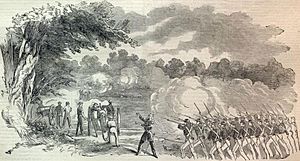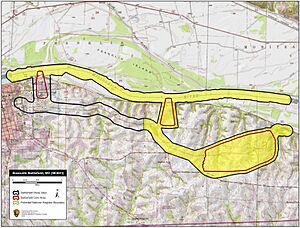Battle of Boonville facts for kids
Quick facts for kids First Battle of Boonville |
|||||||
|---|---|---|---|---|---|---|---|
| Part of the Trans-Mississippi Theater of the American Civil War |
|||||||
 The Battle of Boonville, Mo. by Orlando C. Richardson |
|||||||
|
|||||||
| Belligerents | |||||||
| Commanders and leaders | |||||||
| Units involved | |||||||
| 1st Missouri infantry 2nd Missouri infantry 2nd U.S. Infantry 2nd U.S. Artillery |
Missouri State Guard | ||||||
| Strength | |||||||
| 1,700 | ~1,500 | ||||||
| Casualties and losses | |||||||
|
5 killed or died of wounds 7 wounded |
5 killed or died of wounds 10 wounded 60-80 captured and paroled |
||||||
The First Battle of Boonville was a small but important fight during the American Civil War. It happened on June 17, 1861, near Boonville, in Cooper County, Missouri. Even though not many people were hurt, this battle had a big impact.
The Union army won, which helped them control the Missouri River. This victory also stopped efforts to make Missouri join the Confederacy.
Four battles took place at Boonville during the Civil War. This article mainly talks about the first one. You can find out about the others later in the section about other battles.
Contents
Why Did the Battle of Boonville Happen?
Missouri's Divided Loyalties in 1861
When the Civil War began, Missouri was a "border state." This meant people there were split on whether to support the United States (the Union) or the new Confederacy. The governor, Claiborne Fox Jackson, wanted Missouri to join the Confederacy.
However, most people in Missouri wanted to stay neutral. A special meeting of the state government decided not to leave the Union.
Early Conflicts and the Camp Jackson Affair
Even so, those who wanted to join the Confederacy tried to get weapons. They took a small federal armory in Liberty, Missouri. Their next plan was to take a much bigger weapons store in St. Louis.
But a smart young officer, Captain Nathaniel Lyon, stopped them. Lyon worked with Missouri Congressman Frank Blair and German immigrants in St. Louis. Together, they protected the arsenal for the Union.
On May 10, 1861, Lyon used his soldiers to capture the Missouri Volunteer Militia at Camp Jackson near St. Louis. This militia was supposedly just doing drills, but many believed they were helping the Confederacy.
The St. Louis Riot and New State Guard
When Lyon marched his captured prisoners through St. Louis, a riot broke out. People were killed. That night, the Missouri government met quickly. They created the Missouri State Guard, which supported the Confederacy.
Governor Jackson was given special powers to "stop invasions" by Union forces. The new State Guard began forming groups across the state. Many volunteers went to Jefferson City to protect the state capital. They feared a Union attack.
Failed Peace Talks Before the Battle
The Price–Harney Truce
People tried to make peace between the two sides. General William S. Harney, a Union commander, and Major General Sterling Price of the Missouri State Guard agreed to a truce. They promised to keep order and avoid fighting.
Harney agreed to keep Union soldiers mostly in St. Louis. Price said he would stop gathering State Guard volunteers in Jefferson City. He also promised to fight with the Union if Confederate forces entered Missouri.
Governor Jackson's Secret Plans
But at the same time, Governor Jackson was secretly talking with Confederate leaders. He asked them to send an army into Missouri. He promised the Missouri State Guard would help them fight the Union.
Union supporters in Missouri felt Harney was trusting Governor Jackson too much. They thought this truce was dangerous. They asked President Lincoln's government to remove Harney, and he was replaced by General Nathaniel Lyon on May 30.
The Final Meeting and Declaration of War
Lyon, Jackson, and Price met one last time on June 11 in St. Louis. Governor Jackson demanded that Union forces stay only in St. Louis. He also wanted all pro-Union groups in Missouri to give up their weapons.
Lyon refused Jackson's demands. He said he would rather see everyone in the state "dead and buried" than let Jackson tell the federal government what to do. Lyon ended the meeting by saying, "This means war."
The Retreat to Boonville
Governor Jackson and General Price quickly left for Jefferson City on June 12. They ordered bridges on train lines to be burned. They soon realized Jefferson City couldn't be defended.
So, Jackson and the State Guard moved to Boonville the next day. General Lyon quickly followed them by steamboat. He had about 1,700 soldiers with him. His goal was to take the capital and scatter the State Guard.
Price hoped to gather more State Guard units at Boonville. However, he planned to leave Boonville if Lyon got too close. Colonel John S. Marmaduke began organizing his unit at Boonville. But Price became ill and left Boonville, putting Governor Jackson in charge.
Jackson decided to fight, even though his men were not well-trained. They mostly had shotguns and hunting rifles. Colonel Marmaduke did not want to fight, but he had to lead the State Guard forces.
Lyon reached Jefferson City on June 15. He learned Jackson and Price had gone to Boonville. Lyon left 300 soldiers to guard the capital. On June 16, he continued chasing Price, landing near Boonville on June 17.
The Battle of Boonville: A Quick Fight
The battle itself was very short, more like a small fight than a big battle. But it was one of the first important land battles of the war. It had serious effects on the Confederacy's hopes in Missouri.
Union Advance and State Guard Retreat
Lyon's soldiers marched towards Boonville around 7 AM. About 500 of Marmaduke's State Guard waited on a ridge. They had no cannons. Governor Jackson, watching from a distance, kept his best soldiers out of the fight.
Lyon's troops met State Guard guards as they got closer. Lyon sent out skirmishers (soldiers who spread out and fight in small groups) and pushed his men forward. Union cannons quickly forced out sharpshooters from a nearby house.
Union infantry soldiers fired at the State Guard, making them retreat. This part of the fight lasted only about 20 minutes. The State Guard tried to regroup, but they failed when Union soldiers attacked their side. Cannons from a riverboat also fired at them.
The "Boonville Races"
As Marmaduke had feared, the State Guard's retreat quickly turned into a full run. The soldiers fled through their camp and the town of Boonville. Some went home, while others retreated with the Governor to the southwest part of Missouri. Lyon took control of Boonville by 11 AM.
Because the fight was so short and the State Guard ran away so fast, the battle was nicknamed "The Boonville Races."
Who Was Hurt and What Was the Impact?
Casualties of the Battle
The Union army had very few casualties. Five soldiers were killed or died from their wounds, and seven were injured.
For the Missouri State Guard, about five were killed or died from wounds, and ten were injured. Around 60 to 80 State Guard soldiers were captured. Lyon also took their supplies, including two cannons without ammunition, old muskets, shoes, tents, and food.
The Battle's Big Impact
The real importance of the Battle of Boonville was strategic. It was much more important than the small number of people hurt. The battle pushed the Confederate-supporting forces out of central Missouri. This helped the Union keep control of the state.
It became hard for Confederate supporters to send messages or get supplies from the Missouri River valley. People who wanted to join the Southern army from north of the Missouri River also found it difficult.
The battle also lowered the spirits of the Missouri State Guard. Even though they would win other battles later, this early defeat was tough. Lyon's victory gave the Union time to strengthen their hold on Missouri. Colonel Marmaduke was so disappointed that he left the Missouri State Guard and joined the regular Confederate Army.
Other Battles at Boonville
After the first battle on June 17, Boonville was the site of three other smaller Civil War fights:
Second Battle of Boonville
The Second Battle of Boonville happened on September 13, 1861. Colonel William Brown led 800 Missouri State Guard men to attack 140 pro-Union Boonville Home Guardsmen. The Union soldiers were eating breakfast.
Because of rain, the Confederates covered their flags in black. The Home Guard thought this meant "no mercy," so they fought extra hard. They defeated the State Guard, and Colonel Brown was killed.
Third Battle of Boonville
The Third Battle of Boonville took place on October 11, 1863. This was during "Shelby's Great Raid." General Joseph Shelby's Confederate troops fought Union forces in the city. When more Union soldiers arrived the next day, the Confederates left.
Fourth Battle of Boonville
The Fourth Battle of Boonville was on October 11, 1864. Union soldiers fought parts of General Sterling Price's Confederate army, who had taken over the town. The Confederates won this small fight, but they left the city the next day.
Images for kids




